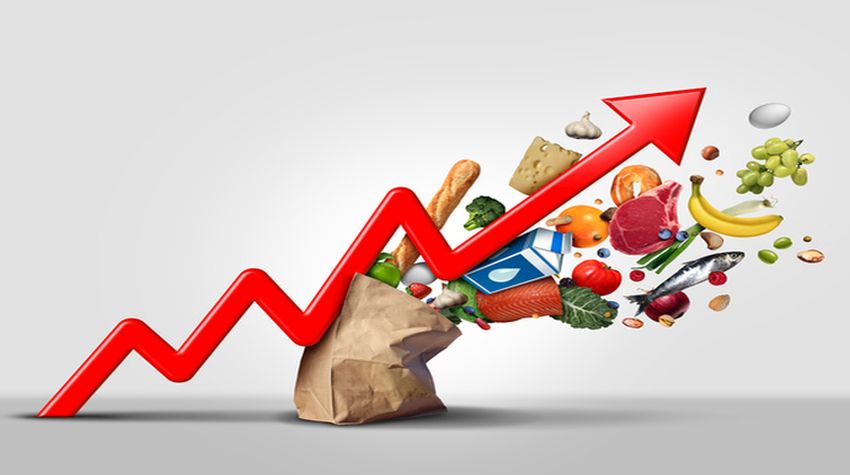
Inflation. The new but not so pretty buzz word. You’ve likely heard it millions of times over the last several months and you’ve definitely experienced it, within your bank account. The price of everything has gone up. And it’s not just high-ticket items; it’s groceries, it’s gas, it’s everyday items that fuel your household and your lifestyle. Feeling broke lately? You’re not alone.
Due to a number of factors, including supply chain issues following global Covid-19 pandemic lockdowns and the Russian-Ukrainian conflict, inflation is making all kinds of goods — from groceries to gas — much more expensive than they were even a few months ago. In June, inflation hit 8.1%, the highest year-over-year increase seen since the 1980’s.
Even when it’s not at a high-point, inflation is an unavoidable reality for all Canadians. No matter the economic conditions, the price of goods eventually rises over time and your money will buy less than it once did. The amount that increase occurs (expressed as a percentage) is the rate of inflation.
Where inflation really starts to impact the average Canadian is when the increase in the price of goods outpaces the increase in wages, compromising your purchasing power. When inflation hit that 8.1% mark in June, hourly wages rose just 5.2%.
How to Hedge Against Inflation
So, what can the average Canadian do about these rising costs? Fortunately, you don’t need to earn a finance degree or enlist a financial advisor to deal with inflationary woes. In fact, advisors recommend using the same sensible money-saving tactics they share during boom times, such as tracking expenses, tackling debt, and avoiding risky investments.
- Track Your Spending Closely
Budgeting is the mainstay advice of personal finance advisors everywhere but keeping to a rigid plan is more difficult than ever. How do you keep to a predetermined limit when the price of everything from milk to Mercedes’ are rising every month? While you may be able to hold off on buying a Benz, the price of essentials, like groceries and gas, have increased, too.Eating is an expensive habit, and it’s not something we can cut from our budget — we’ve got to eat. When we hit up the grocery store, inflation is hitting us back.While you can’t simply buy less food, going to the grocery store armed with a list and your calculator app can help you save. By considering unit pricing, this is the cost per measurement, usually by 100 grams at grocery chains like Food Basics or Metro, you can get more of your favourite foods for less.
The results of a little math are often surprising. Family deals can be more expensive than smaller purchases and sometimes that’s on purpose. Shrinkflation, where brands shrink the size of a product but keep the price the same, can bite.
- Tackle Debt as Fast as Possible
Canadians owe a lot of money. In fact, StatsCan estimates the average consumer owes $1.73 in consumer credit and mortgage liabilities for every dollar of their income. This high debt-to-income ratio isn’t new, but the Bank of Canada’s current overnight rate of 2.5% (which is 10 times higher than it was at the end of 2021) is making interest rates on loans higher, meaning those debts are even more expensive to pay off.And, of course, inflation means there’s less spare cash to pay off your loans. If you are spending more money on food, rent and gas for your car, that leaves less money to service your debt. The first tip to surviving inflation, unsurprisingly, is to tackle consumer debt as fast as possible to avoid the snowball effect of interest rates overwhelming your finances.
If you have multiple debts, you should tackle the one with the highest interest rate first. This means a payday loan repayment, which could have the equivalent of a 500% interest rate, should take priority over a credit card with a standard 19.99% rate.
Once you’re free of your largest debt, turn your attention to the one with the next highest interest rate. But what happens if you can’t pay everything back? If reducing your expenses or getting a side hustle isn’t enough to destroy your debt, asking your bank for a balance transfer offer may help.
The premise is straightforward: if you transfer a balance to your credit card up to its limit, you can keep it on the credit card at 0% interest for anywhere from six to 12 months. Taking advantage of something like that during this climate is amazing, this is a way to still pay down your debts, and pay them down faster, without the crazy interest rates.
- Use Cash Back Credit Cards or Bank Accounts
Earning cash back on essential expenses like gas and groceries can be a simple way to put money back in your pocket. It’s a way to make sure that every dollar you spend is coming back to you in some way. Typical cash back credit cards will give about 1% to 2% back — not a whole lot, but certainly better than nothing. However, some cards can give up to 5% back on groceries, for instance, and others have welcome offers offering 10% back in your first few months.
If you go the credit-card route, keep all of your everyday expenses on it to reap the maximum rewards possible. However, make sure to do your research and avoid overspending. Your cash back won’t really be a win if you end up paying interest charges or a hefty annual fee.
- Learn to Love Coupons
You probably need all the help you can get with your grocery bill at the moment. Fortunately, major chains like Metro, Loblaws, and Walmart still offer flyers—perhaps you know, the ones your parents or grandparents read religiously for the latest deals—but you don’t have to grab a paper copy every week just to see where you can save the most. Coupon apps allow anyone to save on food, even food that’s close to its expiry date, but still edible. Some of these apps double as grocery lists. Unfortunately, there are downsides to coupon apps, handy as they may seem. Oftentimes, it encourages you to buy things that you wouldn’t otherwise buy, ultimately, it’s up to the individual to make sure they’re sticking to their grocery list and ideally, having some sort of a meal plan.
- Avoid Volatile Investments
Despite 2021’s relatively brisk performance, inflation is souring in world markets. Tech giants like Shopify and cryptocurrencies like Ethereum have lost billions of dollars in valuation over the past year, while central banks are warning of impending recession. But that doesn’t mean the stock market is a complete write-off.Investors should look very carefully at companies with a lot of debt. Interest payments are rising, of course, and a company that owes money is paying it back at a much higher rate than they did a year ago. Pick companies with solid financial performance, you want to buy stocks in companies that are likely—and I use that word ‘likely’ very carefully—to perform better than other companies in a rising rate environment. A utility might be more attractive to an investor right now than a tech company or a bank if the latter is holding a lot of debt. Investors aren’t likely to see much in the way of returns if a company’s CEO is forced to spend a lot of their revenue just shoring up existing debt.
If you’re looking to build a diverse investment portfolio that preserves capital, GICs are also an option. At EQ Bank for example, customers can lock in a 1-year GIC at 4.35%. Since a GIC guarantees repayment of the deposit plus interest, it can be a great way to ensure some cash down the road. Plus, the current interest rate situation is actually a boon for them right now.
But one of the most important pieces of advice — can be summed up simply: stay the course. The markets don’t just move up in a straight line, you’re going to get a lot of bumps along the way. And this is just another bump.
Following Financial Common Sense
With a recession likely on the horizon, it is easy to panic and assume you need to find a brilliant hack to survive these inflationary times with your finances intact. But tried-and-true financial wisdom will do just fine.
In fact, even if inflation conditions improve by the time, you read this article, you should consider adopting the suggestions above to keep you on track.
If we implement these things as part of our lifestyle, then when we see the economy shift — when we see inflation shift — we’re already equipped, and we don’t have to try to scramble to change things.









